When sesame seeds (til) and jaggery (gud or gur) come together, it’s just firework on the palate! Just like this Sesame Laddu. No doubt, this is one of my favorite combinations, as not just supremely tasty, it is also a wholesome package. Apart from these 2 main ingredients, these Til Ke Laddu also have peanuts and coconut which only enhance the flavor and makes these nutty laddus, a loved one. This sweet is a Makar Sankranti special as well as a vegan recipe.
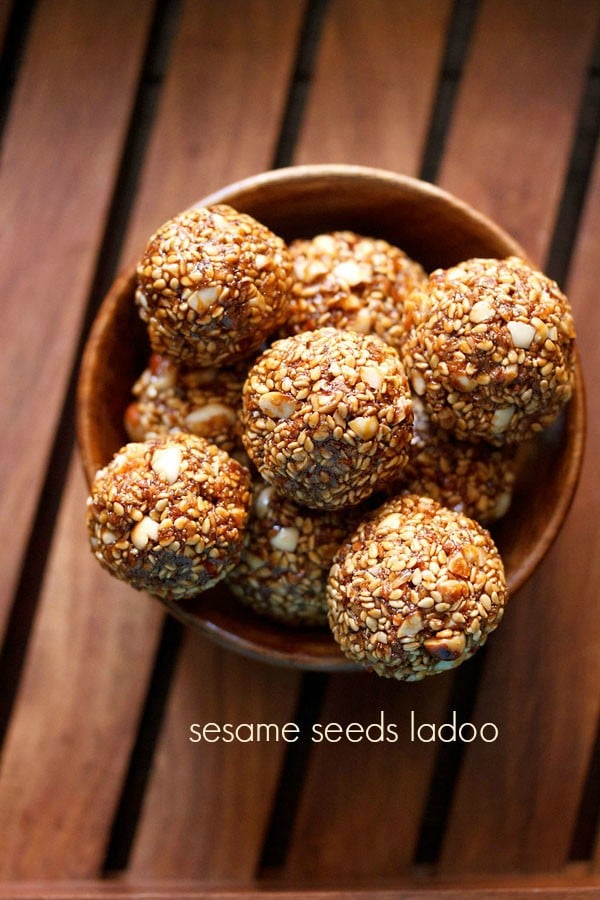
About Til Ke Laddu
Til Ke Laddu simply means laddu or sweetened balls made from white sesame seeds and jaggery. While growing up in a Maharashtrian community in Mumbai, Maharashtra, Til Gul Ladoos (‘til’ meaning sesame and ‘gul’ meaning jaggery) were shared with everyone during the festival of Makar Sankranti.
While doing so, a common Marathi phrase was spoken, which was – ‘til gul ghya, god god bola.’ When you translate, it means ‘take til, gud (sesame, jaggery) and speak sweetly.’ Then, by the time dusk approached, we would have a big jar of the sweet Sesame Laddu and sugar candies. We would happily gorge on these.
Such is the prominence of this pairing, especially when it is in the form of these Til Ke Laddu that also has jaggery and other lovely ingredients in it. Like peanuts and desiccated coconut. Isn’t this a truly winning combination in terms of taste and textures? Wouldn’t you agree too?
I would also say that if you are a fan of peanuts as well, then you must check this recipe of Peanut Laddu too. It is easy, sumptuous and made with just 2 ingredients – ground peanuts and jaggery. I would really call these as protein-rich balls of goodness!
About My Recipe
In this Sesame Laddu recipe, I have cooked the jaggery to a soft ball stage. So, this gives the ladoos a soft and chewy texture. You can also cook the jaggery syrup to a hard ball stage. However, if doing so, you will get firm and dense ladoos. The choice is yours, as both ways, it will taste good.
There are many ways to make these Til Ke Laddu. This post has one of the ways, while this Til Gud Ke Ladoo is made in another way, where the sesame seeds are ground. and doesn’t require you to make a jaggery syrup.
Sesame Laddu makes for a great, warming sweet snack during winters as well. Apart from this, these ladoo made of sesame and jaggery also are a good source of plant proteins, fibre, antioxidants, has inflammatory properties and many other health benefits.
Make them, store them and have them, whenever you wish to. This Til Ke Laddu recipe makes for about 10 to 12 ladoos. But it is easy to double or triple the quantities and make larger batches. These ladoos also stay good for a couple of weeks, in air-tight containers or boxes.
How to make Til Ke Laddu
Roast Sesame Seeds
1. Heat a kadai or pan and add ⅓ cup sesame seeds to it. The pan should not be too hot, but on low heat.
Tip: You can use both hulled seeds or unhulled white sesame seeds. I have used unhulled sesame seeds.
Note that unhulled seeds are lightly bitter but are superior flavor-wise. But in this recipe, the bitter taste is not felt as jaggery overpowers the bitterness.
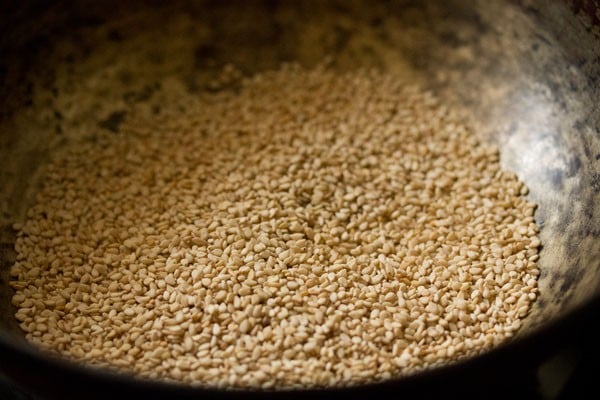
2. On low heat, roast the sesame seeds. Stir at intervals.
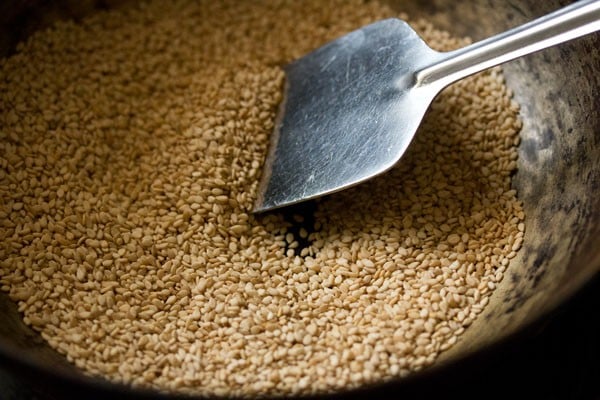
3. The sesame seeds pop and change color. On low heat, this takes about 2 to 3 minutes. Do not brown them.
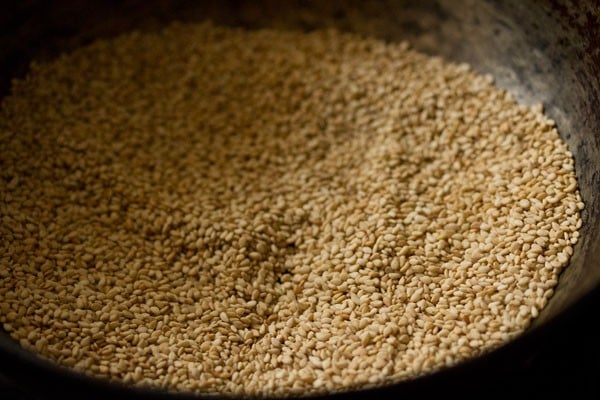
4. Once the sesame seeds are roasted well, remove them and keep aside on a plate.
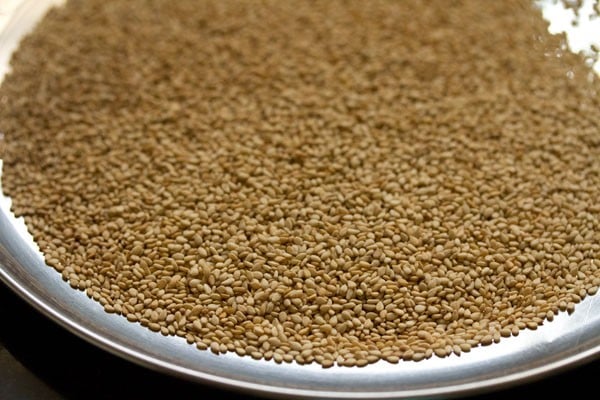
Roast Peanuts
5. Next, add ¼ cup peanuts to the same pan. These are raw peanuts and not toasted or salted peanuts.
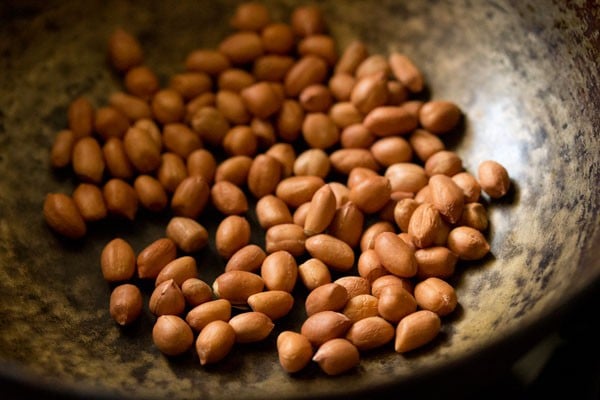
6. Dry roast the peanuts on low heat till they become crunchy and get a few black spots or blisters on them. Stir often.
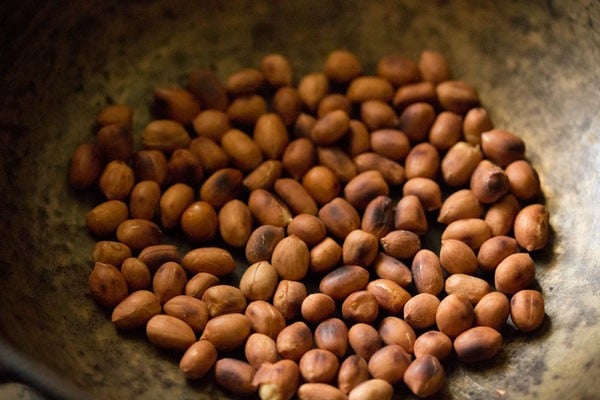
7. Remove the peanuts in a mortar pestle. Allow to cool. If you want, you can remove the peanut skins by rubbing them between your palms, once they are cooled.
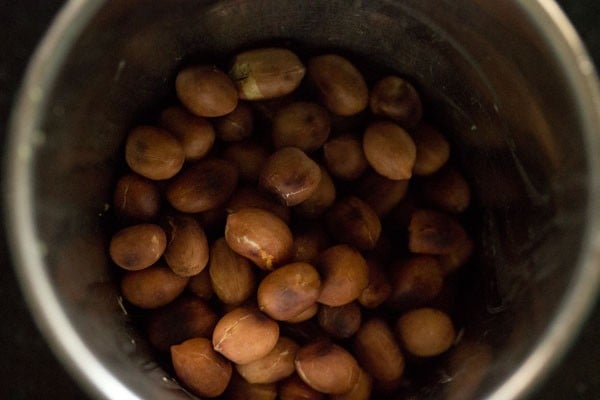
Roast Desiccated Coconut
8. In the same pan, add ¼ cup desiccated coconut.
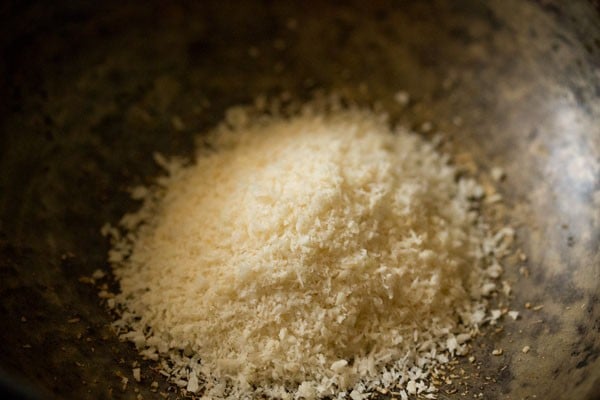
9. Stir continuously while roasting the coconut.
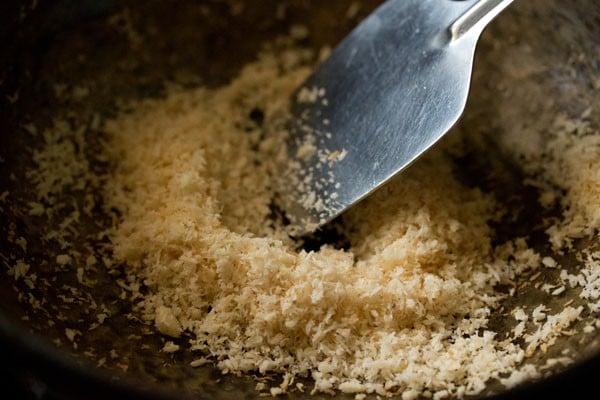
10. Roast the coconut until it becomes light golden or golden. Switch off the heat.
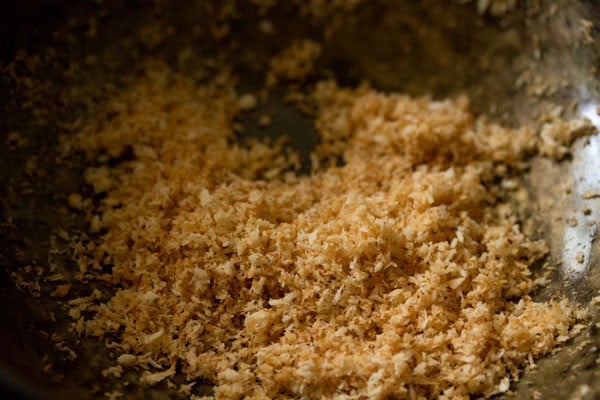
Make Laddu Mixture
11. Add the roasted coconut to the roasted sesame seeds.
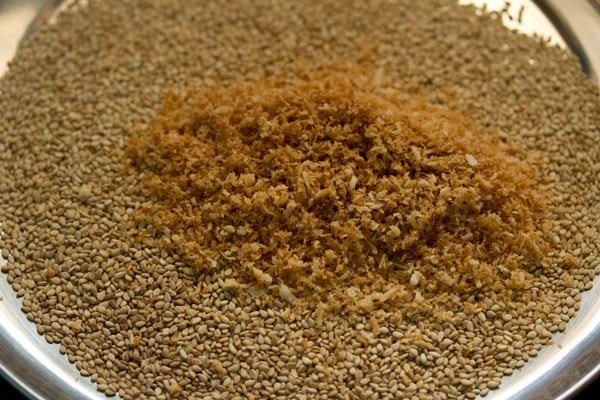
12. When the peanuts have cooled, crush them coarsely. You can also crush them in a blender or spice grinder.
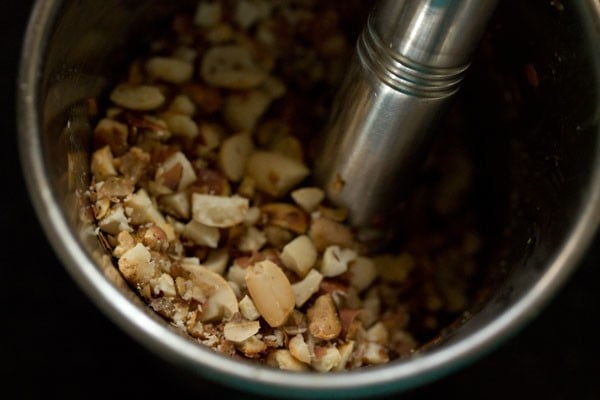
13. Add the coarsely crushed peanuts to the roasted coconut and sesame seeds.
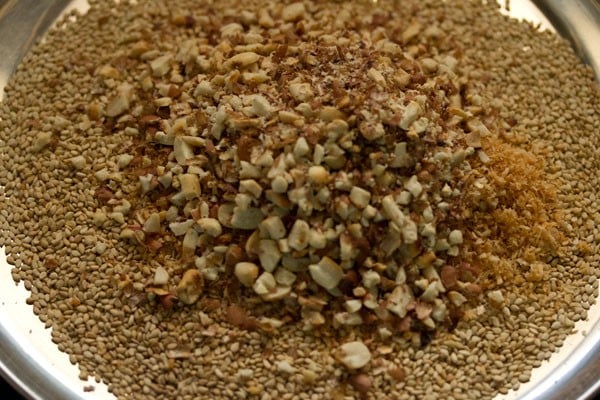
14. Next, add ¼ teaspoon green cardamom powder.
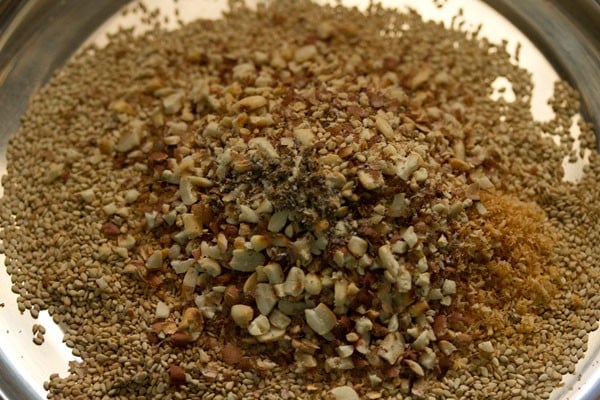
15. Mix very well. Set aside.
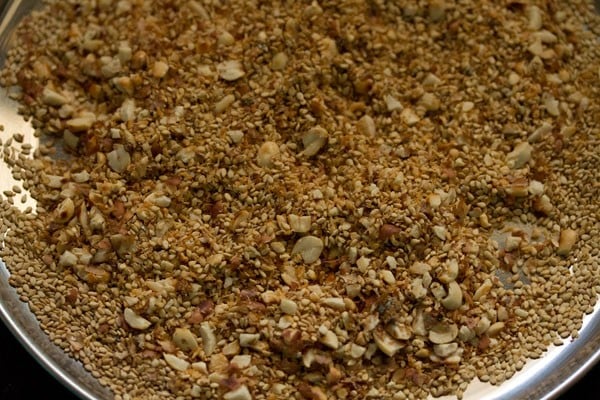
Make Jaggery Syrup
16. In the same pan or kadai, take ½ heaped cup powdered jaggery or grated jaggery. You can use jaggery powder, like I have done or chop or grate a jaggery block.
The special soft and sticky jaggery called “chikki jaggery” can also be used to make these ladoos.
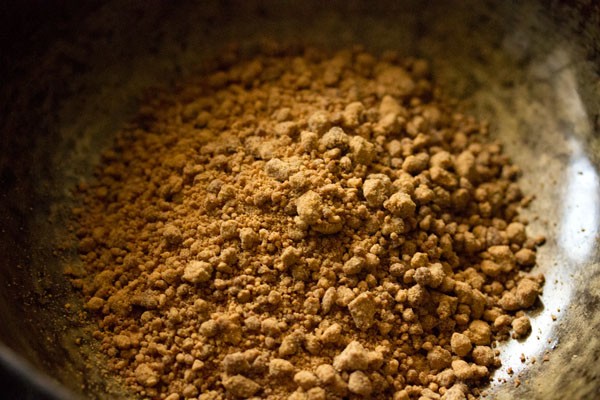
17. Add 3 tablespoons water.
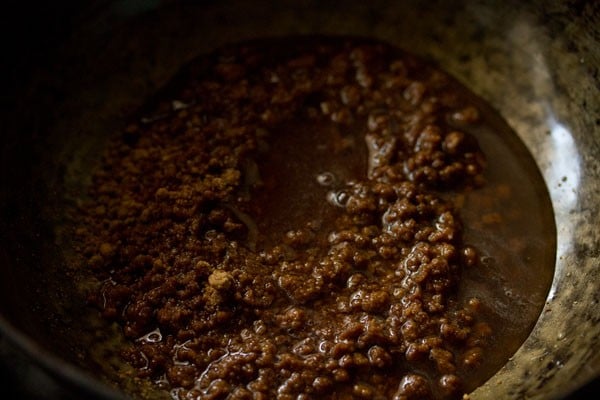
18. Keep the kadai or pan on the stovetop on low heat.
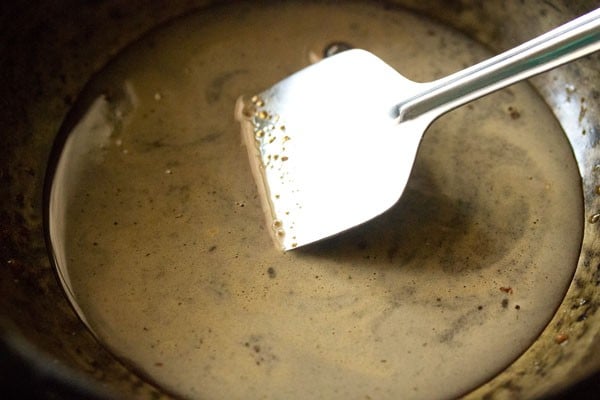
19. Keep on stirring the jaggery so that it dissolves.
Tip: If the jaggery has impurities, then filter the solution and keep the filtered jaggery syrup back on the stovetop. I used organic powdered jaggery, so there were no impurities.
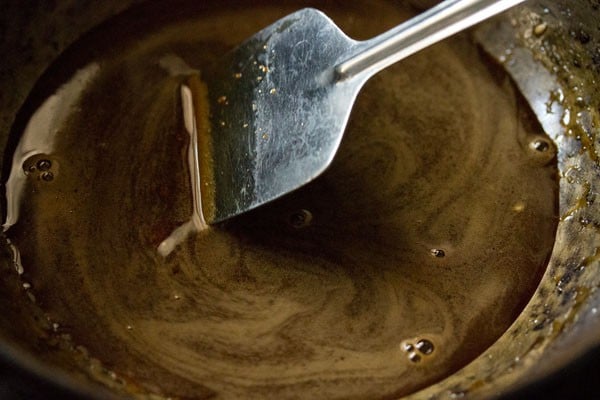
20. On low heat, simmer the jaggery syrup. It will start bubbling first.
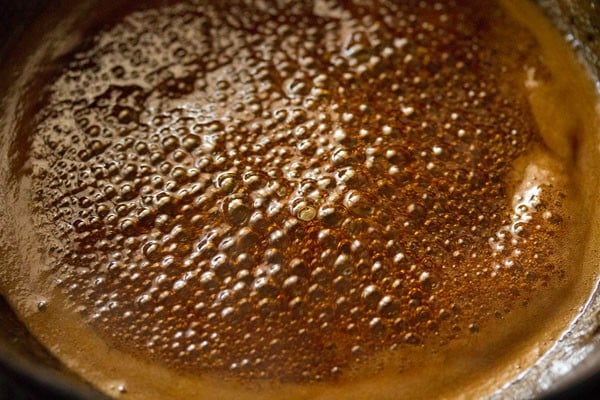
21. You have to cook until the jaggery syrup comes to a soft ball stage. Keep stirring non-stop.
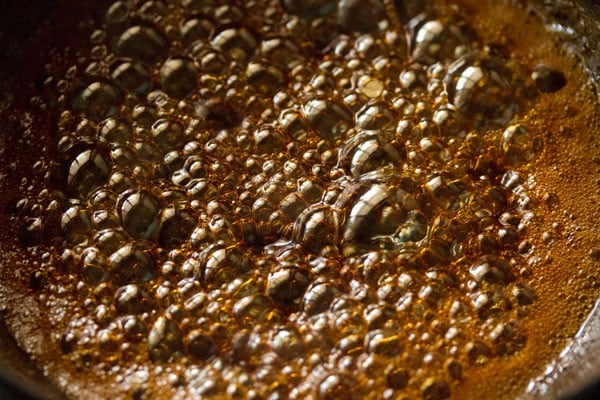
22. To check the soft ball stage, take some water in a small bowl. Drop a bit of jaggery solution in the water. Remove it. It should be sticky and form itself into a soft ball.
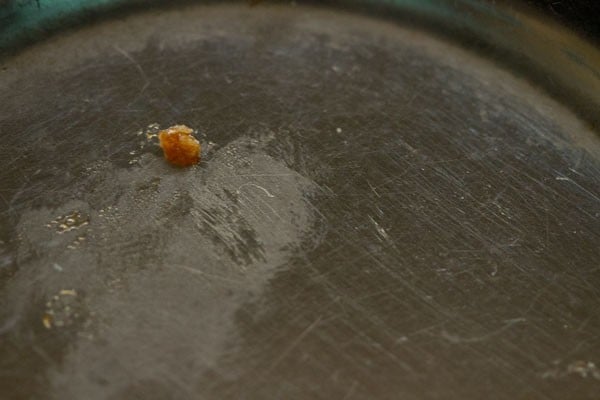
23. At this consistency in the picture below, the soft ball stage had reached in the jaggery syrup.
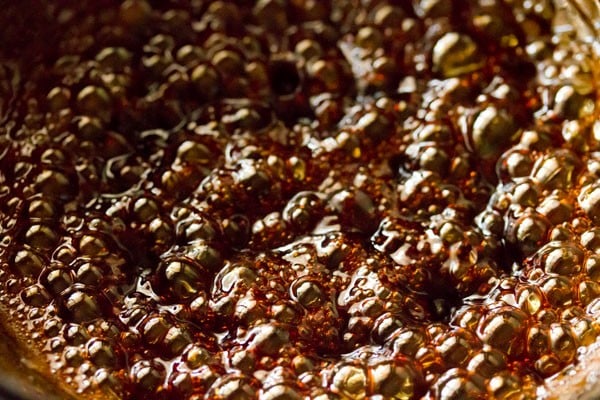
Make Til Ke Laddu
24. At this stage, switch off the heat and add the roasted mixture of sesame seeds, desiccated coconut, crushed peanuts and cardamom powder.
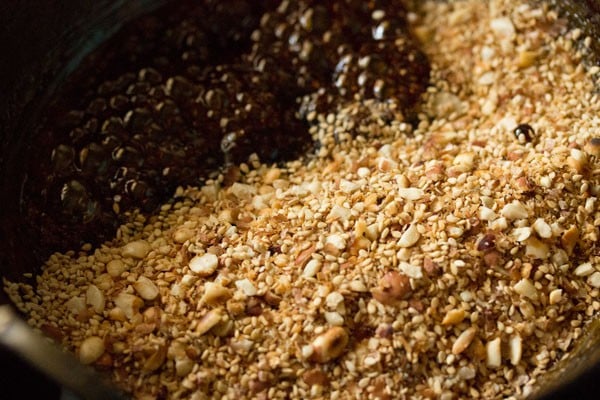
25. Mix the roasted mixture with the jaggery solution quickly and thoroughly.
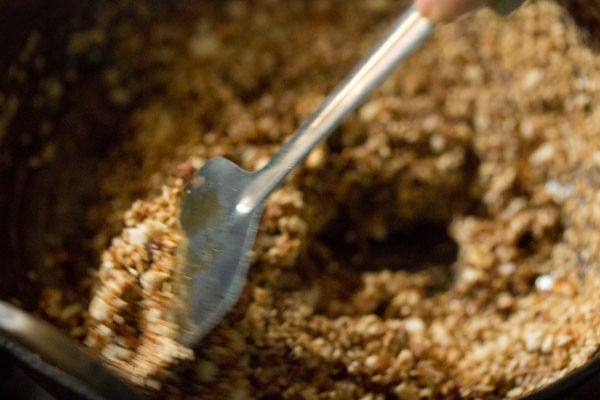
26. Keep the pan on your kitchen countertop or work surface.
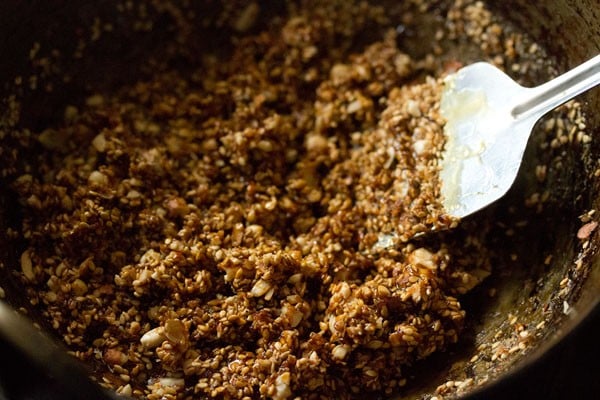
27. When the mixture is still hot, begin to form and shape ladoos from it. If it is too hot, wait for a minute and then form the ladoos.
Spread some oil or water in your palms to form the ladoos. If you are not able to shape when the mixture is too hot, wait for some seconds and then make the Sesame Laddu.
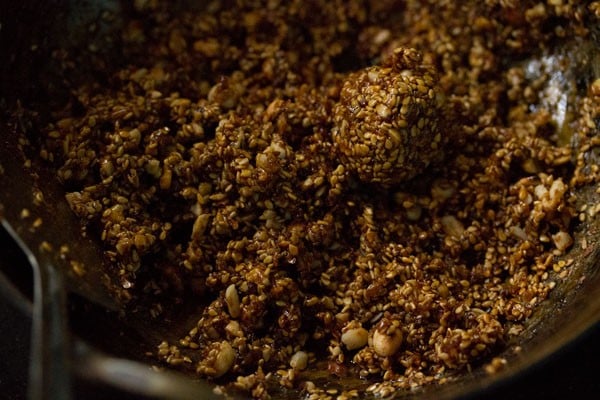
28. You can also use a ½ to 1 tablespoon measure spoon, for scooping the mixture and making the ladoo. Then, just shape the ladoos once you scoop them out.
Do shape, when the mixture is hot. If the mixture cools down, then the Til Ke Laddu cannot be made.
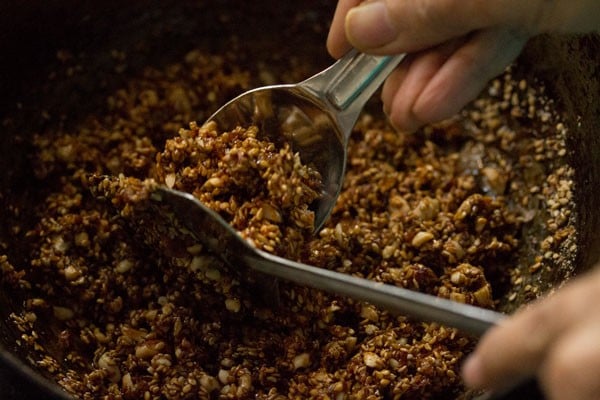
29. For the last batch, scrape the sides very well and then make ladoos from it.
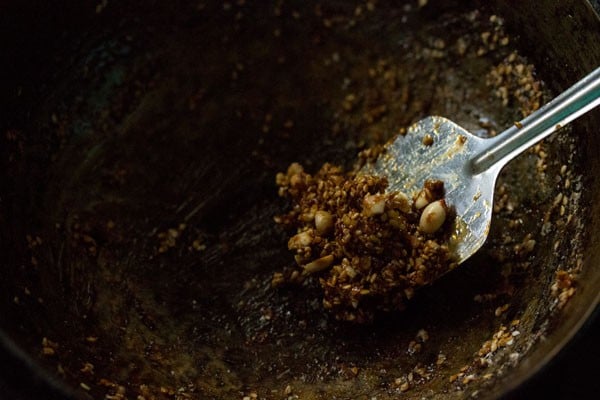
30. Make Sesame Laddus this way. Store in an air-tight jar at room temperature.
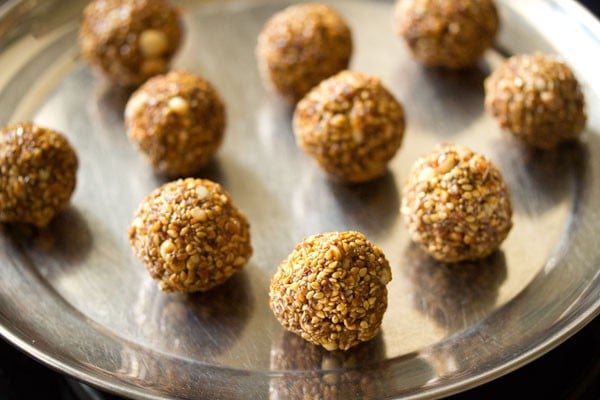
31. Serve Til Ke Laddu during Makar Sankranti festival or have them as a sweet snack.
You can easily double or triple the recipe and make a large batch that can be stored in an air-tight container for a couple of weeks.
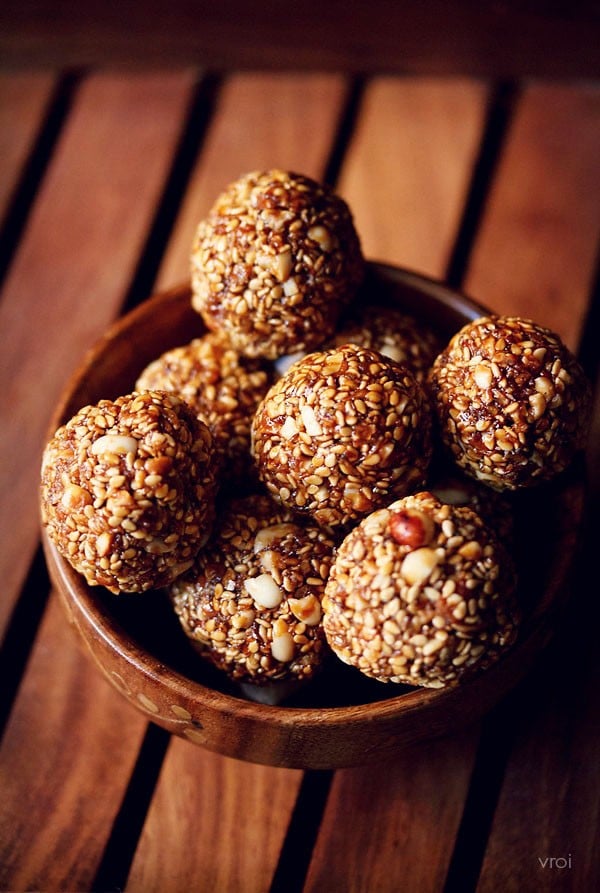
Expert Tips
- Roasting: This is an essential part, where the sesame seeds should be roasted till they pop and turn crisp. Ensure to not brown them. Similarly, peanuts have to be roasted till crunchy. If you are using toasted/roasted sesame seeds or peanuts, then omit the roasting steps while making this recipe.
- Sweeteners: Traditionally, this recipe calls for jaggery (an unrefined sugar made from sugarcane juice). However, if you do not have jaggery, then use sugar. Simmer the sugar syrup on low heat till it reaches a soft ball stage. Also, with sugar, the taste of the ladoos will be more caramel-like. You can use both white or unrefined cane/raw sugar for this.
- Sesame seeds: Both hulled or unhulled white sesame seeds can be used for this recipe. But remember, unhulled seeds will be slightly bitter, but superior flavor-wise. Also, in these ladoos, you won’t get the bitterness as the sweetness of the jaggery overpowers it.
- Peanuts and desiccated coconut: You can omit adding peanuts and desiccated coconut in this recipe, if you do not prefer them or are allergic. But in this case, use ¼ cup more of sesame seeds to replace the peanuts.
- Cardamom powder: Cardamom powder gives a nice fragrance to the ladoos. If you do not have it, make the ladoos without it.
- Make til chikki or sesame brittle: If you are unable to shape due to the mixture being too hot, then pour the mixture in a greased or parchment-lined pan. Let it cool and set. Then, remove and slice to make til chikki or sesame brittle.
FAQs
Cooking jaggery syrup to a soft ball stage is a crucial step in making these ladoos. You have to be attentive when the jaggery syrup is cooking and keep stirring often. An easier way is to check the consistency using a candy thermometer.
If you do not have a candy thermometer, follow the steps I have outlined in the step-by-step guide above – that is to drop a bit of jaggery solution in some water taken in a bowl.
The water cools the syrup and when you remove it, the consistency should be sticky and form itself into a soft ball. It should not be fluid and mix in the water or look like strands.
You can easily make these Til Ke Laddu with both hulled or unhulled white sesame seeds. Hulled sesame seeds have their outer hulls or husks removed and are white, cream or off-white in color.
Unhulled sesame seeds do not have their hulls removed. So, they have a tan or light brown or brown color and are somewhat bitter in taste.
Using unhulled sesame seeds is fine when making any ladoo, as we use a sweetener (jaggery, in this recipe). So, you do not feel the bitterness while eating as it is overpowered by the sweetener.
I always make any variety of Sesame Laddu with unhulled sesame seeds, as I find they taste way better than the ones made with hulled or polished white sesame seeds.
If your laddu mixture has become hard, add a few splashes of water to it. Mix thoroughly on low heat and cook for a few minutes. Mixing with water and heating it will change the consistency and soften it.
Check for the soft ball stage (even if the mixture has the sesame seeds, peanuts, etc.). Switch off heat and shape into balls.
If you cannot bind the Sesame Laddu, it means the jaggery syrup needs to be cooked more and has not reached the soft ball stage. So, you can take the entire mixture in a pan on low heat.
Then, stir and cook for some minutes until it reaches the soft ball stage. Check it with the test, I have mentioned in the step-by-step guide above.
More Ladoo Recipes To Try!
Ladoo Recipes
Ladoo Recipes
Ladoo Recipes
Please be sure to rate the recipe in the recipe card or leave a comment below if you have made it. For more vegetarian inspirations, Sign Up for my emails or follow me on Instagram, Youtube, Facebook, Pinterest or Twitter.
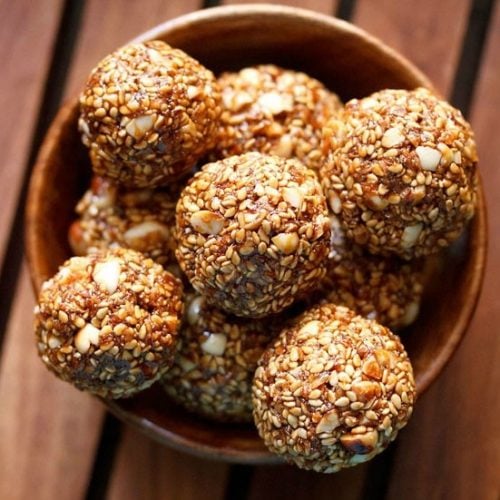
Til Ke Laddu | Sesame Laddu
Ingredients
- ⅓ cup white sesame seeds – 50 grams, unhulled or hulled
- ¼ cup peanuts
- ¼ cup desiccated coconut
- ½ cup powdered jaggery or grated jaggery (heaped) – 100 grams
- 3 tablespoon water
- ¼ teaspoon cardamom powder (ground cardamom)
- water or oil – a bit for greasing the palms
Instructions
Roasting ingredients
- Heat a kadai or pan and add the white sesame seeds in it. The pan should not be too hot, but on a low heat.
- On a low flame roast the sesame seeds. Stir at intervals.
- The sesame seeds pop and change color. On a low heat, this takes about 2 to 3 minutes. Do not brown them.
- Remove and set aside in a plate.
- Then add the peanuts. Dry roast the peanuts on a low heat stirring often until they become crunchy and get a few black spots or blisters on them.
- Remove the peanuts in a mortar-pestle or on a plate. Allow them to cool.
- In the same pan, add the desiccated coconut.
- Stir continuously and roast the coconut until it become light golden or golden. Switch off the heat. Remove from the pan and set aside.
- When the peanuts have cooled, crush them coarsely. You can also crush them in a dry grinder.
- Add the coarsely crushed peanuts to the roasted coconut and sesame seeds.
- Next add the cardamom powder.
- Mix very well. Set aside.
Making jaggery syrup
- In the same pan or kadai, take the powdered jaggery or grated jaggery and water.
- Keep the kadai on the stove top on a low heat.
- Keep on stirring the jaggery so that it dissolves in the water.
- On a low heat simmer this jaggery and water solution. It will start bubbling first.
- You have to continue to cook till you come to a soft ball stage in the jaggery solution.
- To check the soft ball stage, take some water in a small bowl. Drop a bit of jaggery solution in the water. The water will cool the jaggery syrup and when you remove it, the consistency will be sticky and forming a soft ball.
Making til ke laddu
- At this stage, switch off the heat and add the dry roasted mixture of sesame seeds, desiccated coconut, crushed peanuts and cardamom powder.
- Mix the dry roasted mixture with the jaggery solution thoroughly.
- Keep the pan on your work surface or kitchen countertop.
- When the mixture is still hot, begin to shape til laddu from it. If too hot, then wait for a minute and then form the laddu. Spread some oil or water in your palms to shape the ladoo. If you are not able to shape laddu when the mixture is too hot, wait for some seconds and then shape the laddu
- You can also use a ½ to 1 tablespoon measuring spoon for scooping the mixture and making the til ke laddu Then just shape the laddu once you scoop them out.
- For the last batch, scrape the sides very well and then make til ladoo from it.
- Make all the til ladoo this way. Store in an airtight jar at room temperature.
- Serve til ke laddu ladoo during makar sankranti or have them as a sweet snack.
Notes
- Soft ball consistency: Cooking jaggery syrup to a soft ball consistency is an important and crucial step in this recipe. You have to be attentive when the jaggery syrup is cooking and keep stirring often. An easier way is to check the consistency using a candy thermometer. If you do not have a candy thermometer, follow the steps I have outlined in the step-by-step guide above – which is to drop a bit of jaggery solution in some water taken in a bowl. When the water cools the jaggery syrup, then you remove it and the consistency should be sticky and form itself into a soft ball. It should not be fluid and mix in the water or look like strands.
- Sesame seeds: You can easily make this recipe with both hulled or unhulled sesame seeds. Unhulled sesame seeds are slightly bitter to taste. Using unhulled sesame seeds is fine when making ladoo as we are also using a sweetener, so you do not feel the bitter taste when eating.
- If the laddu mixture has become hard: In this case, add a few splashes of water to the mixture. Place on low heat on the stovetop and mix thoroughly and cook for a few minutes. Mixing with water and heating it will change the consistency and soften it. Check for the soft ball stage (even if the mixture has sesame seeds, peanuts in it). Switch off heat and shape into balls.
- If til laddu is not binding: If you cannot bind and shape, this means the jaggery syrup needs to be cooked more and has not reached the soft ball stage. So place the entire mixture in the pan on low heat. Cook for some minutes until you reach the soft ball stage. Check the soft ball stage test, with the points I have mentioned in the step-by-step guide above.
- Making til chikki or sesame brittle: If you are unable to shape due to the mixture being too hot, then pour the mixture into a greased or parchment-lined pan. Let it cool and set. Then remove and chop to make sesame chikki or brittle.
- Sweeteners: The traditional til laddu recipe calls for jaggery which is an Indian unrefined sugar made from sugarcane juice. If you do not have jaggery, then use sugar. Simmer the sugar syrup on low heat until you get the soft ball consistency in it.
- Peanuts and desiccated coconut: You can omit adding peanuts and desiccated coconut in the recipe if you do not prefer them or are allergic. But replace peanuts with more ¼ cup sesame seeds.
- Roasting: You need to roast or toast the sesame seeds until they pop and become crisp. Do not brown them. For peanuts, roast them really well until they are crunchy. If you use pre-toasted/roasted sesame seeds or peanuts, then simply omit their roasting steps when making the recipe.
- Cardamom powder: Cardamom powder gives a nice aroma. If you do not have it, then skip adding.
Nutrition Info (Approximate Values)
This Til ke Laddu recipe from the archives, originally published in January 2016 has been updated and republished on January 2023.
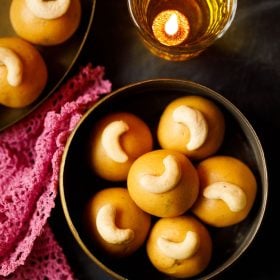
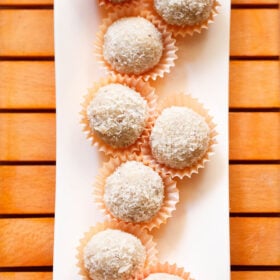
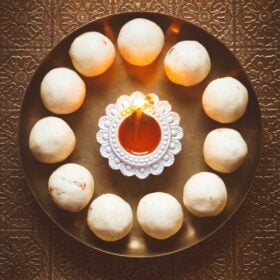
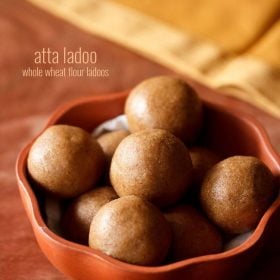
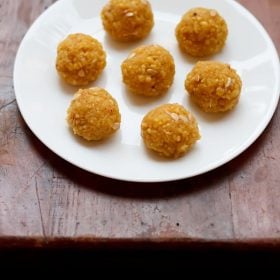
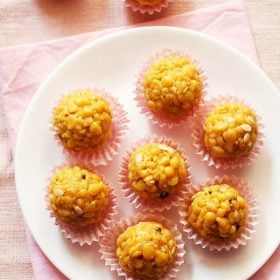








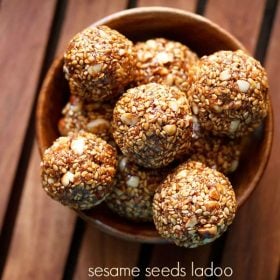
Thank you for this recipe! I was so nervous about making Til Ladoo for the first time, as the chashni can be tricky. But your instructions were very clear and easy to follow.
Ladoos have come out really well- not hard and just the right sweetness too. This will be my go to recipe for til ladoos!
Great! Thanks a lot for the super feedback on the recipe. I am glad that the recipe instructions were helpful.
I am a huge fan of laddu, so this type i also liked a lot. So yummy mmmmm!